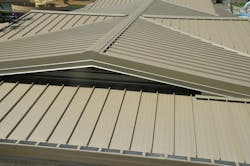Metal Roof Retrofits: the potential, the problems, the payoff, part 1
A few weeks back I wrote a blog post suggesting roofing contractors diversify their construction expertise and acquire additional revenue streams by getting into the retrofit roofing market.
A membrane or built-up flat roof that requires a framing system to produce an adequate slope represents the greatest retrofit challenge to the roofing contractor and arguably the greatest benefit when done correctly. This retrofit will result in lower energy and maintenance costs, even though the initial costs of a metal retrofit may be higher. The total lifecycle costs in the long run actually make it the lowest cost alternative.
However, as with most things in construction, the consequences of not rising to the challenge are high—wasted time and money, and the tarnished reputation of the contractor. For the best possible outcomes when working on these kinds of retrofits, consider some simple but vital steps to get the best possible outcome from your retrofit job.
Find out what type of roof panel your customer wants. This is, in one sense, a no brainer. But make sure you get the particulars. What’s the desired slope? Does the customer want hips, valleys, gable end walls or other vertical walls at high or low eaves? Does the roof need to have a specified UL rating?
Find out as much as you can about what the customer currently has. Some things will be evident upon inspection. But get as thorough answers as possible to the following:
- Building size and eave height
- Secondary structural type (steel joist, steel beam, wood joist, concrete beam, etc.)
- Secondary structural pacing and orientation (Are the secondary structurals running parallel to the length of the building, perpendicular or both?)
- Type of roof deck (metal, wood, concrete, etc.)
- Does the roof have parapet walls?
- Does the roof have air conditioning or other equipment on it?
- What is the governing code for this building? (ICC, IAPMO, NFPA or some variation). Keep in mind local jurisdictions can customize their adoption of these codes.
- A copy of the original blue prints, though not absolutely necessary, would be incredible helpful. Make sure the blue prints reflect the actual built condition. If a retrofit framing system is designed based on blue prints showing steel joists 5'-0" but the building was built with joists of 6'0", the integrity of the framing could be seriously jeopardized.
Look For Hidden Problems. Some things aren’t so easy to spot. Better you find them now than your customer call you back to fix their consequences later. I’ll talk more about that, and two other important steps to take to insure a smooth metal roof retrofit, in my next post.

